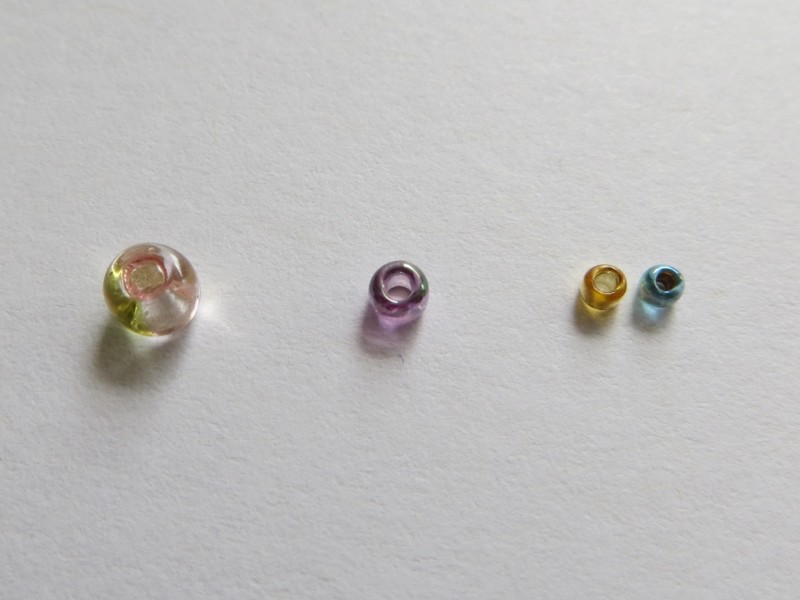In the last post, I just told about two main ways to add beads to your knitting: stringing and crochet methods. This time, I’m talking about the size of materials – yarn, beads and crochet hook.
Obviously, we can’t add any size beads to any weight yarn, but yarn weight/beads size equation depends on the method you opt for. But let’s talk about beads, these tiny things.
I did a little search on the internet to gather information on beads sizes. Among myriad of website selling Japanese seed beads, just a few stores provide both the bead diameter and the hole size.
Here’s the list of values declared by the online stores for two sizes commonly used for knitting of two major manufacturers. The first one is beads diameter, the last one hole size (and 1 mm = 0.0393701 inch!).
| Maker & Size | Aura Crystals | MAXBeads | Perles and co. | i-beads |
|---|---|---|---|---|
| TOHO 6 | 4mm / 1.5mm | 4mm /1.5mm | 3.5mm /1.7mm | |
| MIYUKI 6 | 4.3- 4.4mm /1.45- 1.55mm | 4.5mm / 1.2mm | ||
| TOHO 8 | 2.8- 3.2mm /1.10- 1.15mm | 3mm / 1mm | 3mm / 1.2mm | 3mm / 1.4mm |
| MIYUKI 8 | 3mm / 1mm |
The values are not always concordant, sometimes not so reliable, but we can notice that Toho’s beads have larger holes for the same diameter. And I had the confirmation on the Miyuki‘s site (that I’ve finally had the idea of going to). They say Round 6/0: 4mm/1.5mm, and Round 8/0: 3mm/1.1mm (and I add that Toho says their beads have larger holes, without providing values). It’s a matter of 0.1 mm, but it counts in the case of knitting! And if they have larger holes, they are lighter and you have more beads for the same weight 🙂 This is important if you want your lacy airy featherweight shawl to remain light (yes, I love Toho’s beads!).
With this, let’s come back to our main subject: yarn-bead equation.
If you want to skip to the crochet method section, click here.
For stringing method, in general, your yarn could be, or should be relatively thick. Indeed, since beads are on a single thread as you can see on the photo (I used slipped stitch with yarn in front), the yarn diameter should be close to the hole size. Otherwise, your beads would be wobbly.

But are you afraid it couldn’t pass? Don’t worry, normally plied yarns contain air and get easily thinner when you slide beads along yarn.
The yarn on the photo is light sport weight one (Baby Alpaca Silk from Drops, 167 m=183 yds per 50g=1.8oz) and the beads used are the size 8/0 from Toho, 3 mm diameter with 1.20 mm hole. And it seems to me a perfect combination! You can add them also to fingering or light fingering weight yarn.
With 6/0, I think you can easily go up to sport to DK weight yarn.
What about thinner yarn?
There are a few smaller sizes commonly imported in Europe or the US, 11/0 and 15/0. The 11/0s from Toho are 2.0-2.2mm, whereas those from Miyuki 2.0mm (hole size: 0.8 mm). The 15/0s are 1.5mm for both manufacturers (hole size: 0.7mm) and clearly, they are not for knitting!
(I’m sorry to say Toho commercializes 10/0=2.4mm size but I haven’t found it on European online store… Perhaps because Miyuki doesn’t?)
The 11/0 beads are almost impossible to work with for knitting. But if I say “almost”, there is a little hope: Takumi LH of Toho! They have in fact developped size 11/0 (and 10/0s) beads with larger holes (by 15%), named Takumi (artisan). And LH 11/0s (2.2mm/±0.9m) can be used with a beading needle and a lace weight yarn!
The two rightmost beads are 11/0s, the gold one Takumi LH and the blue one, a normal 11/0. Can you see the LH’s hole is very slightly larger?
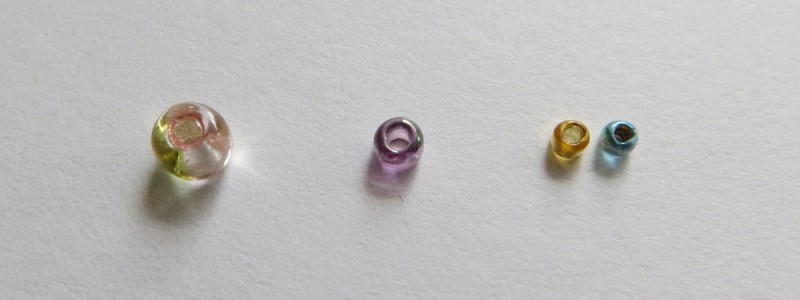
(From left to rigt: Miyuki 6/0 Chartereuse Pink, Toho 8/0 Hydrangea Gold Luster, Toho Takumi LH 11/0 Silver Lined Gold et Toho 11/0 Rainbow Aqua)
11/0 LHs(gold) get through, whereas normal 11/0s(blue) are blocked…
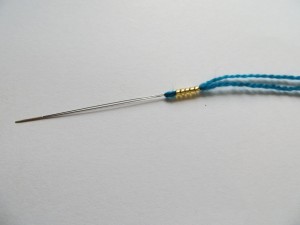
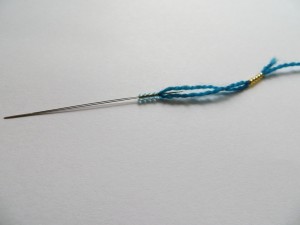
They’re very tiny and discreet, but if it’s the intended effect, they are for you 😉
I wouldn’t however recommend single ply lace yarn for stringing method because it’s too fragile, nor thick yarn (DK and above) for the aesthetic reason.
With the crochet hook method, yarn passes twice in beads and that adds stability and sturdiness. But there’s an unexpected (?) obstacle: crochet hook!
Actually, beads accept only very fine crochet hooks, the sizes generally used are from 0.6 mm to 1.0 mm (US 12). And size range differs from one country to another:
| Diameter | USA | Japan | France | 0.5 mm | US17 | JP14 | 0.5mm | 0.6 mm | – | JP12 | – | 0.75 mm | US14 | JP10 | 0.75mm | 0.9 mm | US13 | JP8 | – | 1.0 mm | US12 | JP6 | 1.0mm |
But wait, why 1.0 mm crochet does’t pass through 1.2 mm hole, you may think? That’s because the size of crochet is not that of “hook”(=head) but the diameter of the shaft. And the hook could be larger than the shaft…
And of course, you can’t grab a thick yarn with a tiny crochet hook, nor pass through the beads’ hole. If your hook’s head is too tiny compared to the yarn, you’re likely to split it.
The combinations generally recommended are:
– Fingering weight yarn = size 6/0 (4 mm) beads = 0.75 – 1.0 mm hook;
– Lace weight yarn = size 8/0 (3 mm) beads = 0.6 – 0.75 mm hook.
I knitted my Starry pullover, currently tested, with a light sport weight yarn (Baby Alpaca Silk from Drops, 167 m=183 yds per 50g=1.8oz) and the beads used are 8/0 (3 mm with 1.2 mm hole), with 0.75 mm crochet hook.
This combination is not so recommended, and I have to say it was tricky, but I like the result. And I think I was right to work with size 8/0 beads, because, as they are lighter, the front is not much heavier than the back knitted simply in Stockinette stitch. In the meantime, I’ve discovered that Toho’s 8/0s accept a 0.90 mm crochet hook (I’ve bought a Clover’s 0.90 mm crochet for the tutorials and it works incredibly better – good tools make your life easier!).
So I recommend this size for those who want to add beads to all over the front.
Based on this experience, I made my personal sizing table (yep, I like tables too).
| Bead size | 8/0 (3mm) | 6/0 (4mm) |
|---|---|---|
| Hole size | 1.1-1.2 mm | 1.2-1.5 mm |
| Hook size | 0.6 – 0.9mm | 0.9 – 1.0 mm |
| Yarn weight | Lace to fingering | Fingering to sport |
Please note that as I have been explaining, the hole size differs from one company to another. So not every 8/0s would accept a 0.90 mm crochet. Also, choose the largest crochet hook the hole size accepts, you’re less likely to split your yarn.
Phew, such a looooong talk about so tiny things (here, 4 beads on the top of this post on a A4 paper)!
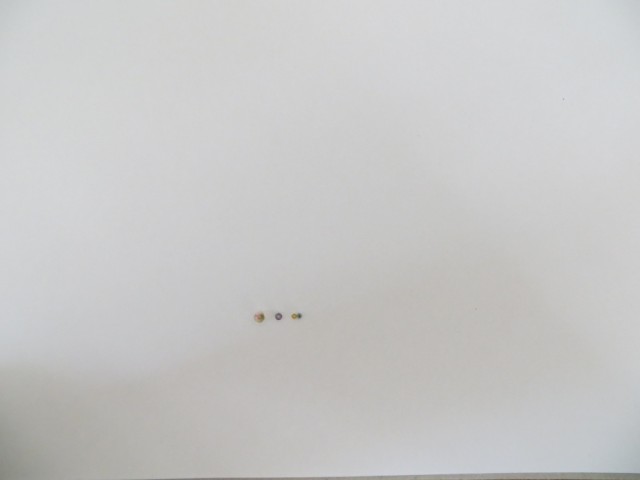
In the next and the last post, I’m going to talk about a variant of the crochet hook method, which will make your beading much easier 🙂

